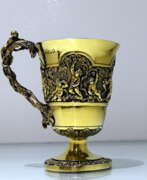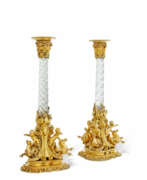Victorian period 19th century


Lawrence Alma-Tadema was a Dutch-British artist renowned for his detailed and romanticized portrayals of ancient civilizations, particularly Rome and Egypt. His meticulous attention to historical accuracy and the lavish representation of marble and luxurious settings distinguished his work. Notably, his fascination with ancient cultures was sparked by his honeymoon visit to Italy and Pompeii, influencing his artistic focus for decades.
Lawrence Alma-Tadema's early work, such as "The Education of the Children of Clovis," showcased his interest in historical subjects and established his reputation. This painting, alongside others like "The Sad Father," demonstrates his commitment to historical detail and narrative depth.
After moving to England due to the Franco-Prussian War and personal reasons, Lawrence Alma-Tadema's career flourished. His works, characterized by their bright palette and refined details, resonated with Victorian audiences, earning him considerable fame and financial success. He was knighted in 1899 and continued to be a pivotal figure in Victorian art, influencing peers and future generations alike.
Lawrence Alma-Tadema's legacy experienced a decline posthumously but saw a resurgence in the 1970s. Today, he is celebrated for his contributions to the Neoclassical and Victorian art movements, with his works featured in prominent collections worldwide, including the Getty Museum and the Tate Gallery.
If you are fascinated by Lawrence Alma-Tadema's artwork and wish to stay updated on sales and auction events related to his works, consider signing up for updates. This will ensure you remain informed about new opportunities to explore and possibly acquire pieces of his illustrious legacy.


William Powell Frith was a British painter.
Frith studied at the Royal Academy School and fairly quickly began to exhibit there, becoming a Fellow of the Royal Academy in 1852. Frith became famous for his scenes of contemporary English life, including those with moralizing overtones. His multi-figure, complex compositions depict a wide variety of Victorian backgrounds. He was a traditionalist and an opponent of the Pre-Raphaelites, ridiculing them in his works.


John Atkinson Grimshaw was an English Victorian-era artist best known for his nocturnal scenes of urban landscapes. He was called a «remarkable and imaginative painter» by the critic and historian Christopher Wood in Victorian Painting (1999).
Grimshaw's love for realism stemmed from a passion for photography, which would eventually lend itself to the creative process. Though entirely self-taught, he is known to have used a camera obscura or lenses to project scenes onto canvas, which made up for his shortcomings as a draughtsman and his imperfect knowledge of perspective. This technique, which Caravaggio and Vermeer may also have used, was condemned by a number of his contemporaries who believed it demonstrated less skill than painting by eye, with some claiming that his paintings appeared to «show no marks of handling or brushwork», while others "were doubtful whether they could be accepted as paintings at all". However, many recognised his mastery of colour, lighting and shadow, as well as his unique ability to provoke strong emotional responses in the viewer. James McNeill Whistler, who Grimshaw worked with in his Chelsea studios, stated, «I considered myself the inventor of nocturnes until I saw Grimmy's moonlit pictures».


John Frederick Herring the Elder was a British painter of Victorian England.
John had a passion for horses and painting from a young age. In his spare time from his day job as a sign painter and coachman, Herring painted horses for innkeepers and customers. Developing his talent, John specialized in drawing animals and loved to depict sporting events with horses. His impressive and vivid depictions of racehorses, cows and ducks as well as picturesque hunting scenes caught the eye of Queen Victoria. In 1845 Herring was appointed animal painter to Her Royal Highness the Duchess of Kent, followed by a commission from the reigning Queen Victoria, who remained a patron for the rest of his life.
A highly successful and prolific artist, Herring is considered one of the most important animal painters of mid-19th century Europe. He exhibited at the Royal Academy, the British Institution, and the Society of British Artists, where Herring became vice-president in 1842. Three of his sons also became artists.


Sidney Richard Percy, an English landscape painter of the Victorian era, gained recognition for his depictions of grazing cattle set against scenic backgrounds. His landscapes featured earth tones, soft greens, and delicate pastel hues, showcasing remarkable attention to detail. Percy's interest in photography influenced his artwork, incorporating figures from his own photographs of gypsies into his paintings. While some critics disapproved of these additions, Percy's works remained popular during the early part of his career, with patrons including Prince Albert. However, as artistic tastes shifted towards impressionism, Percy's popularity waned. Despite the decline in demand for Victorian landscapes in recent years, his paintings continue to be highly sought after.
Percy's versatility extended beyond oil paintings, as he also created small watercolors on cardboard known as "potboilers." These quickly executed pieces were sold to sustain his income while working on larger, more time-consuming oil paintings. Although he outlived his peak popularity, Percy's contributions to the art world earned him a distinguished place among the Williams family of painters. Today, his artworks command higher prices at auctions compared to his contemporaries, though there has been a reported decrease in demand for Victorian landscapes in recent times. Nonetheless, Sidney Richard Percy's talent and popularity during his time solidify his status as a celebrated painter.


Marc-Louis-Emmanuel Solon, pseudonym Miles, was a renowned French porcelain artist. After beginning his career at the Sèvres Porcelain Factory, he moved to Stoke-on-Trent in 1870 to work at Mintons Ltd, where he became the leading exponent of the technique of ceramic decoration called pâte-sur-pâte. His work commanded high prices in the late Victorian period.


Paul Storr was an English goldsmith and silversmith working in the Neoclassical and other styles during the late 18th and early 19th centuries. His works range from simple tableware to magnificent sculptural pieces made for royalty.


George Frederic Watts was a distinguished British painter and sculptor associated with the Symbolist movement, celebrated for his allegorical works such as "Hope" and "Love and Life." Born in 1817, Watts's career spanned the Victorian era, during which he developed a style that sought to imbue his works with moral and philosophical depth. His ambition was to affect the viewer's mind through "nobility of line and color," aiming to elevate art to a medium of serious reflection and commentary on humanity's condition.
George Frederic Watts's early influences included the Elgin Marbles and the works of Titian, which inspired him to strive for a grandeur in his art that was both morally uplifting and aesthetically profound. He was a part of the vibrant cultural milieu of the Victorian era, mingling with notable figures of the time in the Prinsep circle of bohemians and contributing significantly to the artistic and intellectual life of 19th-century Britain.
Among Watts's most celebrated works are "Hope," featuring a blindfolded figure with a lyre, and "The Sower of the Systems," a visionary piece that prefigured abstract painting and explored themes of creation and the cosmos. This latter work, completed towards the end of his life, exemplifies Watts's lifelong fascination with the interplay between art, science, and spirituality.
George Frederic Watts's legacy is preserved in the Watts Gallery in Compton, Surrey, dedicated to his work, and through his contributions to public art, including the monumental sculpture "Physical Energy" in Kensington Gardens, London. His portraits of prominent Victorians, which include political, literary, and cultural figures, remain highly regarded for their insight and depth.
For those interested in the intersections of art, culture, and history, George Frederic Watts's work offers a rich exploration of Victorian values, aspirations, and anxieties. His enduring influence on British art and his role in the Symbolist movement make his work a key subject of study for collectors and experts in art and antiques.
To stay informed about exhibitions, sales, and events related to George Frederic Watts, signing up for updates is recommended. This will ensure that enthusiasts and collectors alike are always up-to-date on opportunities to engage with Watts's impactful legacy.































